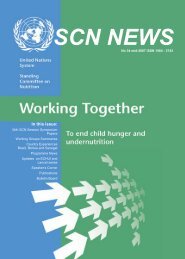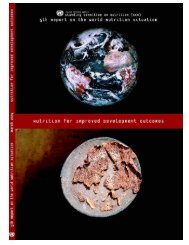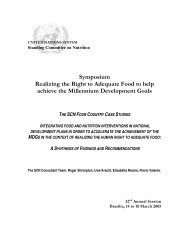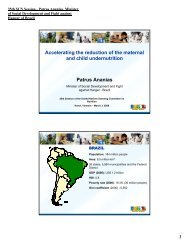Universal Salt Iodization (USI) - FTP Directory Listing
Universal Salt Iodization (USI) - FTP Directory Listing
Universal Salt Iodization (USI) - FTP Directory Listing
- No tags were found...
Create successful ePaper yourself
Turn your PDF publications into a flip-book with our unique Google optimized e-Paper software.
70SPEAKER’S CORNERwww.unsystem.org/scnbox is hard to understand for a layman, and if consumers take the time to study it, it is often misinterpreted.Front-of-pack labels give easier accessible information about the nutritional characteristics of food products.However, we begin to see a proliferation of logo’s and claims, which threatens to make it only harder for theconsumer to trust and understand the variety of messages. (This is further complicated by a simultaneousproliferation of social and ecological labels).Some collective labelling schemes have been proposed, but they often leave it up to the consumer to interpretthe data. The Guideline Daily Amounts (GDA) scheme, adopted by the Confederation of Food and DrinkIndustries in Europe (CIAA), is informative in supplying the key figures; yet the consumer has to comparethese figures in order to deduct the healthy choice. The traffic light system assigns red, amber and green“lights” to products, but again the consumer needs to compare the colour scheme on different alternatives. Ifall lights are red, or all are green, this deduction is not too hard – but usually the picture is much more complicated...An alternative is to apply labels that do the interpretation for the consumer, like “ticks” and “smileys”. In principalthey can be complementary to the more objective schemes like GDA. In these cases, however, it is vitallyimportant that the credibility is safeguarded. Especially if the labelling scheme is carried out by food industry,consumers will tend to distrust the information.One label fits all: The Choices ProgrammeThe Choices Programme is an industry initiative that aims to tackle these challenges. Its essence is a frontof-packstamp on products that pass an evaluation against qualifying criteria, based on international dietaryguidelines. An independent scientific committee, chaired by Prof. Jaap Seidell of the Free University of Amsterdam,is responsible for designing and periodically reviewing the qualifying criteria.The Choices stamp has two distinct effects: it helps consumers in the quick moment of decision to make thehealthy choice, and it stimulates food companies to improve the composition of their products in order to obtaina Choices stamp. The main characteristics of the Choices Programme are: It is simple - One positivestamp makes it easy for the consumer to make the healthy choice in a split second. It is credible - The qualifyingcriteria were derived on the basis of international dietary guidelines. The scientific committee will periodicallyreview the criteria and adapt them to the latest scientific insights and technological developments. Anindependent, accredited certifying agency is to evaluate products against these criteria before they are allowedto carry the Choices stamp. It is globally applicable - The criteria are applicable to all categories offood and beverages. As they were derived from international guidelines, they are valid in all countries. It isopen to all companies - All companies from food industry, retail and catering can participate. Current partnersinclude several SME’s: it is important to note that the programme is not only suitable for the “big guys”. Regulatoryschemes often pose huge problems for SME’s; the Choices Programme is designed to trigger the innovativepotential of smaller companies as much as that of larger ones.Scientific basis: what consumers wantA recently published scientific article by Feunekes et al (2008) describes consumer research into the effectivenessof different labelling formats in four European countries. Consumer friendliness as well as the effecton decision making were investigated. The results show that front-of-pack labelling is indeed effective in influencingthe purchasing behaviour of the consumer. On consumer-friendliness there are only slight differencesbetween most formats, although the more complex schemes appear to be too complicated for those consumersthat describe themselves as having little nutritional knowledge.An important finding is that the more complex formats take some 10 seconds more to interpret than simple“ticks” or “stars”. In the actual shopping environment, where purchasing decisions are usually made in a fewseconds time, simple formats are therefore the most appropriate – like the Choices stamp.Scientific basis: setting the criteria *The objectives of the qualifying criteria are: to limit the intake of saturated fat, trans fat, sodium and addedsugars; to ensure the intake of beneficial nutrients, such as dietary fibre; and, to promote an appropriate en-* The qualifying criteria can be downloaded from www.choicesinternational.org. They have been designed by scientific committees inthe Netherlands and Belgium, and will be reviewed in 2008 by the international scientific committee.SCN NEWS # 35 back to contents







